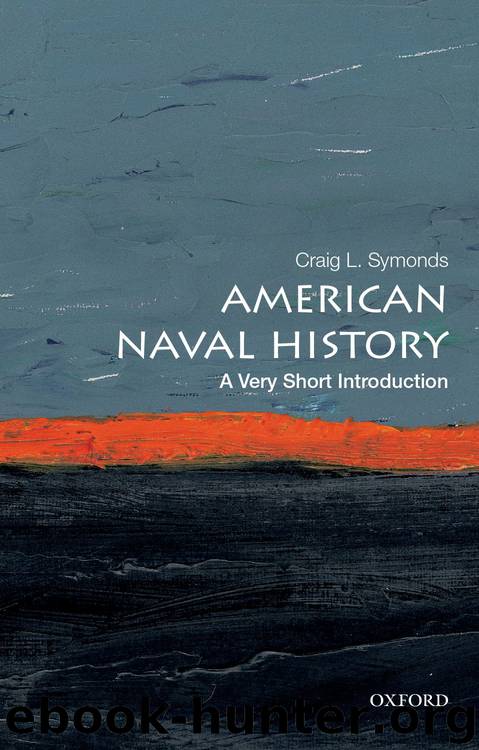American Naval History by Craig L. Symonds

Author:Craig L. Symonds
Language: eng
Format: epub
ISBN: 9780199394791
Publisher: Oxford University Press
Published: 2017-11-10T16:00:00+00:00
The new navy
If there was a single moment in history when the United States abandoned its historic commitment to a militia navy and embraced the idea of a standing peacetime navy, that moment was in 1890, when the confluence of three developments produced a sea change. The first of these was a congressional decision to fund three new battleships, subsequently named Indiana, Massachusetts, and Oregon. Displacing ten thousand tons each, they were much larger than the Maine or the Texas authorized just four years earlier, and they had a more modern look as well, with massive 13-inch rifled guns housed in giant turrets fore and aft. More significant, they were not replacement vessels for aging auxiliary steamers but true seagoing battleships whose primary mission was to fight and defeat other battleships. They were numbered BB-1, BB-2, and BB-3, implying that there could well be others to follow.
The second event of 1890 was the publication of a book burdened with the rather cumbersome title of The Influence of Sea Power upon History, 1660–1783. The work of a previously little known navy captain named Alfred Thayer Mahan, who had spent the previous three years lecturing at the new Naval War College, the book was an analysis of how the relatively small nation of Great Britain had managed to evolve into the most powerful country in Europe and arguably the most powerful in the world, with a global empire on which, as the saying went, the sun never set. The British had been able to do all this, Mahan explained, by seizing command of the seas with its battleship fleet (ships of the line). From that single circumstance flowed all the rest: the wealth that came from trade, the power that came with wealth, and military dominance. Moreover Mahan presented this remarkable achievement as a kind of blueprint, appending a general introduction to the book that itemized the preconditions of naval dominance, and implying (at least) that nations possessing these characteristics could duplicate Britain’s rise to power.
The third circumstance that fed the naval revolution of 1890 was the U.S. census report of that year, which noted the disappearance of the western frontier, suggesting that America’s future growth might extend beyond the boundaries of her continental limits. The construction of the new battleships and the widespread popularity of Mahan’s book seemed to offer both the means and the rationale for the United States to accept the challenge and to duplicate Britain’s success. Mahan’s book did not cause a change in U.S. naval policy, but it provided an intellectual rationale and justification for a policy that was already evolving.
By 1896 all five of America’s new battleships had been completed and launched, and a sixth (the Iowa) joined them a year later. None of these ships had been built to meet a perceived crisis or a national emergency. Instead the United States had finally embraced the navalist argument that a mature nation-state required a naval force of the first rank. Soon enough circumstances would offer an opportunity to test both the ships and the theory.
Download
This site does not store any files on its server. We only index and link to content provided by other sites. Please contact the content providers to delete copyright contents if any and email us, we'll remove relevant links or contents immediately.
| Africa | Americas |
| Arctic & Antarctica | Asia |
| Australia & Oceania | Europe |
| Middle East | Russia |
| United States | World |
| Ancient Civilizations | Military |
| Historical Study & Educational Resources |
1805 by Richard Woodman(858)
Labyrinth of Ice by Buddy Levy(658)
RMS Titanic by Peter Davies-Garner(628)
A Game of Birds and Wolves by Simon Parkin(536)
Life by Tim Flannery(529)
1812: The Navy's War by George C. Daughan(521)
Rogue Warrior by Richard Marcinko(513)
Sontag, Sherry - Blind Man's Bluff by Sontag Sherry(456)
The Rise And Fall of British Naval Mastery by Paul Kennedy(453)
Naval Warfare, 1815-1914 (Warfare and History) by Lawrence Sondhaus(450)
Tracing Your Merchant Navy Ancestors by Simon Wills(433)
American Naval History by Craig L. Symonds(428)
Warship 2019 by John Jordan(427)
The Supercarriers: The Forrestal and Kitty Hawk Classes by Andrew Faltum(409)
Roosevelt's Navy by James Tertius De Kay(384)
The Imperial Cruise by James Bradley(376)
Men-of-War by Patrick O'Brian(376)
The Imperial Cruise: A Secret History of Empire and War by James Bradley(375)
Modern Military Strategy by Elinor C Sloan(357)
